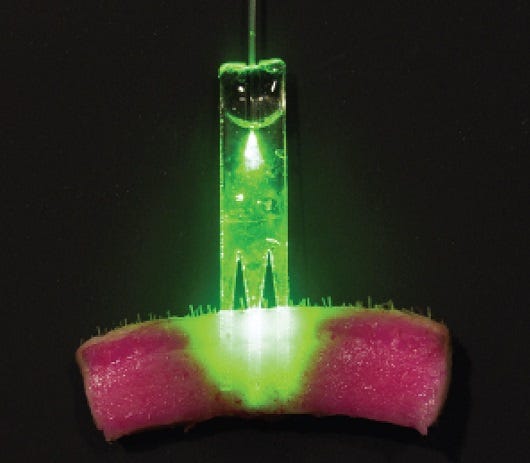Using Light to Suture Wounds
February 26, 2016
A new fiber-optic technology that delivers light deep into human tissue has been harnessed to bond tissue and heal wounds unlike ever before. The breakthrough could transform photomedicine.
Kristopher Sturgis
|
The use of dye in conjunction with green light could be used to stitch wounds. Photo from University of St. Andrews. |
A process known as photochemical tissue bonding (PTB) can be used to treat superficial wounds without sutures or staples. It could also be possibly used to treat tumors.
The technique has advanced recently thanks to the efforts of researchers from the University of St. Andrews and Harvard Medical School, which has developed a bioabsorbable waveguide that uses light to penetrate deeper into human tissue than ever before.
The process involves applying Rose Bengal dye to the wound. The dye will absorb light when exposed to a green wavelength. Once the dye is excited by green light, it enables the tissue at the wound site to stitch itself and form a watertight seal.
"We have seen bioabsorbable components in medicine for a long time already," says Malte Gather, a professor for the school of physics and astronomy at the University of St. Andrews and one of the research leaders. "However, components with optical functions are pretty new. There have been efforts by a few teams world wide over the past few years to realize them. Our work uses a particularly promising class of materials -- bioabsorbable polymers -- as these offer both excellent optical properties, as well as good biocompatibility and adjustable absorption rates. Overall, I would say that having biocompatible and bioabsorbable optical components may indeed transform photomedicine."
Biocompatible and biodegradable polymers have been studied and used in a variety of different fields of medicine, from orthopedics to cardiovascular medicine. When it comes to wound healing, using the PTB method carries increased potential resulting from its ability to not cause any inflammation or scarring at the site of the wound.
While eliminating tissue inflammation and scarring is an obvious benefit, the technique was still limited to superficial wounds with a maximum depth of 1-2 millimeters. It wasn't until the group began using biodegradable waveguides that they were able to push the light to depths up to two inches deep. A process that required some collaboration with researchers from Harvard Medical School.
"We had to design waveguides with specific optical properties," Gather says. "But in order to determine the specifications, a considerable amount of insight into the medical applications was required. Identifying suitable materials required a considerable amount of research. A lot is known about bioabsorption of polymers, but the polymers normally used in this area are not transparent."
The end result was a method that enabled the group to suture a wound 10 millimeters deep on pig skin, all through the use of optical waveguide that enabled tissue crosslinking at impressive depths.
In the future the group is hopeful that these biodegradable polymer waveguides can have applications beyond just the PTB method. Implantable waveguides could further extend the depths of this kind of technology, and could potentially enable deep tissue stimulation that offers new strategies for wound treatment and diagnostic information. The research could also serve as a platform for photodynamic therapy, which could have potential in cancer treatment.
"As you well know, the path to use in patients is always a long one," Gather says. "The waveguides we have demonstrated so far are still fairly simple, and can only transport light through tissue for an inch or two at most. I am excited to see if we can push this further, and hopefully include some additional functions."
Learn more about cutting-edge medical devices at BIOMEDevice Boston, April 13-14, 2016. |
About the Author(s)
You May Also Like



